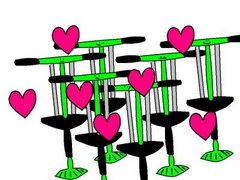The theory goes that when looking at very small scale objects and phenomena traditional Newtonian physics doesn’t apply. This can be proved easily and undisputedly by just looking around our own homes, or my home at least.
To understand the quantum world we must first understand a few basic laws of the Newtonian world –
1. If no one moves stuff then it tends to stay where it is.
2. Apples fall.
3. If someone moves stuff then other stuff gets displaced.
All this is easily shown in a domestic situation, in fact the cupboard under the stairs is the perfect example:
1. It fills up with stuff like plastic bags, apples, displaced aliens and small plastic parachutists. No one moves this stuff so it has stayed exactly there for a very long time. Years, decades, in fact that stuff was there before the house was built and some cunning ancient Welsh builders actually built a whole house around it.
2. If you drop an apple in this cupboard it ALWAYS falls (then it stays where it is proving law 1 again). I have never seen a dropped apple not fall. The only possible exception is if the apple in question is part of a group of three and being used to practice juggling. In this case it tends to fall upwards prior to falling downwards.
3. If by some very unlikely chance someone moves some of the stuff in the cupboard then the other stuff, especially the plastic parachutists and the rotting apples move with the swiftness of a child asked to do the hoovering to fill the gap.
Now to what you might (completely mistakenly) perceive as the trickier problem of Quantum physics. Again a few basic premise –
1. Very small things act very strangely.
2. If you don’t see it then it doesn’t actually happen.
3. Cats are elusive buggers.
Now, the Quantum world and the Newtonian world actually share the same physical space (the world). So obviously to prove the basic laws of Quantum physics we can look at exactly the same space (the cupboard under the stairs).
1, I should have previously mentioned that there are also very small things in the aforementioned cupboard. These include woodlice, those little twinkly bits that fall out of party bags, and dust. Well it goes with out saying that woodlice behave strangely. The twinkly bits always act very oddly in that just when you think you have cleared them off your party clothes/carpet/children they always reappear within seconds. Usually sticking their tongues out at you. And dust, one of the most mysterious of domestic products – where does it come from? Why does it bunch up in some places to make small mouse-like objects and why does it lay flat on other surfaces to shame you in front of your parents? And, most strangely, what is it for and why can’t we use it to power spacecraft?
2. If you don’t see it … well every parent of teenagers knows that story. But with reference to the cupboard, simple, close the door and none of this, even the Newtonian stuff is actually happening.
3. Cats just ARE elusive buggers.
I was going to go on to talk about the quantum strangeness other small objects such as socks, pens and mothers, but I think I have already proved my point.
Einstein didn’t actually believe in Quantum physics, but then, I’m thinking he probably lived in a flat and therefore was lacking the appropriate place to prove such theories.
Subscribe to:
Post Comments (Atom)


2 comments:
The mixture of small things and dust is perhaps my most feared combination. For example, the tiny cups and coins from the Playmobile pirate ship together with the dust balls that always find their way into the plastic box where said tiny pieces are stored. The idea of that box makes me feel sick. I'd hoover up the lot given the choice, and sometimes do.
This has nothing to do with science. Perhaps it's more medical, a phobia of dust and tiny things.
I have named my dust-mites. All of them are called Henry.
Post a Comment